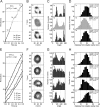Torque generation of Enterococcus hirae V-ATPase
- PMID: 25258315
- PMCID: PMC4223323
- DOI: 10.1074/jbc.M114.598177
Torque generation of Enterococcus hirae V-ATPase
Abstract
V-ATPase (V(o)V1) converts the chemical free energy of ATP into an ion-motive force across the cell membrane via mechanical rotation. This energy conversion requires proper interactions between the rotor and stator in V(o)V1 for tight coupling among chemical reaction, torque generation, and ion transport. We developed an Escherichia coli expression system for Enterococcus hirae V(o)V1 (EhV(o)V1) and established a single-molecule rotation assay to measure the torque generated. Recombinant and native EhV(o)V1 exhibited almost identical dependence of ATP hydrolysis activity on sodium ion and ATP concentrations, indicating their functional equivalence. In a single-molecule rotation assay with a low load probe at high ATP concentration, EhV(o)V1 only showed the "clear" state without apparent backward steps, whereas EhV1 showed two states, "clear" and "unclear." Furthermore, EhV(o)V1 showed slower rotation than EhV1 without the three distinct pauses separated by 120° that were observed in EhV1. When using a large probe, EhV(o)V1 showed faster rotation than EhV1, and the torque of EhV(o)V1 estimated from the continuous rotation was nearly double that of EhV1. On the other hand, stepping torque of EhV1 in the clear state was comparable with that of EhV(o)V1. These results indicate that rotor-stator interactions of the V(o) moiety and/or sodium ion transport limit the rotation driven by the V1 moiety, and the rotor-stator interactions in EhV(o)V1 are stabilized by two peripheral stalks to generate a larger torque than that of isolated EhV1. However, the torque value was substantially lower than that of other rotary ATPases, implying the low energy conversion efficiency of EhV(o)V1.
Keywords: Bioenergetics; Membrane Protein; Molecular Motor; Single-molecule Biophysics; V-ATPase; Vacuolar ATPase.
© 2014 by The American Society for Biochemistry and Molecular Biology, Inc.
Figures






Similar articles
-
Basic properties of rotary dynamics of the molecular motor Enterococcus hirae V1-ATPase.J Biol Chem. 2013 Nov 8;288(45):32700-32707. doi: 10.1074/jbc.M113.506329. Epub 2013 Oct 2. J Biol Chem. 2013. PMID: 24089518 Free PMC article.
-
Single-molecule analysis reveals rotational substeps and chemo-mechanical coupling scheme of Enterococcus hirae V1-ATPase.J Biol Chem. 2019 Nov 8;294(45):17017-17030. doi: 10.1074/jbc.RA119.008947. Epub 2019 Sep 13. J Biol Chem. 2019. PMID: 31519751 Free PMC article.
-
Molecular structure and rotary dynamics of Enterococcus hirae V₁-ATPase.IUBMB Life. 2014 Sep;66(9):624-30. doi: 10.1002/iub.1311. Epub 2014 Sep 17. IUBMB Life. 2014. PMID: 25229752 Review.
-
Direct observation of stepping rotation of V-ATPase reveals rigid component in coupling between Vo and V1 motors.Proc Natl Acad Sci U S A. 2022 Oct 18;119(42):e2210204119. doi: 10.1073/pnas.2210204119. Epub 2022 Oct 10. Proc Natl Acad Sci U S A. 2022. PMID: 36215468 Free PMC article.
-
Structure and dynamics of rotary V1 motor.Cell Mol Life Sci. 2018 May;75(10):1789-1802. doi: 10.1007/s00018-018-2758-3. Epub 2018 Jan 31. Cell Mol Life Sci. 2018. PMID: 29387903 Free PMC article. Review.
Cited by
-
Off-axis rotor in Enterococcus hirae V-ATPase visualized by Zernike phase plate single-particle cryo-electron microscopy.Sci Rep. 2018 Oct 23;8(1):15632. doi: 10.1038/s41598-018-33977-9. Sci Rep. 2018. PMID: 30353110 Free PMC article.
-
Catalytic robustness and torque generation of the F1-ATPase.Biophys Rev. 2017 Mar 25;9(2):103-118. doi: 10.1007/s12551-017-0262-x. eCollection 2017 Apr. Biophys Rev. 2017. PMID: 28424741 Free PMC article. Review.
-
Chemomechanical Coupling in Hexameric Protein-Protein Interfaces Harnesses Energy within V-Type ATPases.J Am Chem Soc. 2017 Jan 11;139(1):293-310. doi: 10.1021/jacs.6b10744. Epub 2016 Dec 23. J Am Chem Soc. 2017. PMID: 27936329 Free PMC article.
-
Na+-V-ATPase inhibitor curbs VRE growth and unveils Na+ pathway structure.Nat Struct Mol Biol. 2025 Mar;32(3):450-458. doi: 10.1038/s41594-024-01419-y. Epub 2024 Nov 21. Nat Struct Mol Biol. 2025. PMID: 39572733
-
Biophysical Characterization of a Thermoalkaliphilic Molecular Motor with a High Stepping Torque Gives Insight into Evolutionary ATP Synthase Adaptation.J Biol Chem. 2016 Nov 11;291(46):23965-23977. doi: 10.1074/jbc.M116.743633. Epub 2016 Sep 13. J Biol Chem. 2016. PMID: 27624936 Free PMC article.
References
-
- Nishi T., Forgac M. (2002) The vacuolar H+-ATPases: nature's most versatile proton pumps. Nat. Rev. Mol. Cell Biol. 3, 94–103 - PubMed
-
- Forgac M. (2007) Vacuolar ATPases: rotary proton pumps in physiology and pathophysiology. Nat. Rev. Mol. Cell Biol. 8, 917–929 - PubMed
-
- Bowman E. J., Bowman B. J. (2005) V-ATPases as drug targets. J. Bioenerg. Biomembr. 37, 431–435 - PubMed
-
- Stewart A. G., Laming E. M., Sobti M., Stock D. (2014) Rotary ATPases: dynamic molecular machines. Curr. Opin. Struct. Biol. 25C, 40–48 - PubMed
Publication types
MeSH terms
Substances
LinkOut - more resources
Full Text Sources
Other Literature Sources

